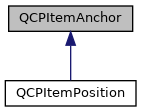An anchor of an item to which positions can be attached to. More...
#include <qcustomplot.h>
 Inheritance diagram for QCPItemAnchor:
Inheritance diagram for QCPItemAnchor:Public Member Functions | |
| QCPItemAnchor (QCustomPlot *parentPlot, QCPAbstractItem *parentItem, const QString name, int anchorId=-1) | |
| Creates a new QCPItemAnchor. | |
| virtual | ~QCPItemAnchor () |
| QString | name () const |
| virtual QPointF | pixelPoint () const |
| Returns the final absolute pixel position of the QCPItemAnchor on the QCustomPlot surface. | |
Protected Member Functions | |
| virtual QCPItemPosition * | toQCPItemPosition () |
| Returns 0 if this instance is merely a QCPItemAnchor, and a valid pointer of type QCPItemPosition* if it actually is a QCPItemPosition (which is a subclass of QCPItemAnchor). | |
| void | addChild (QCPItemPosition *pos) |
| void | removeChild (QCPItemPosition *pos) |
Protected Attributes | |
| QString | mName |
| QCustomPlot * | mParentPlot |
| QCPAbstractItem * | mParentItem |
| int | mAnchorId |
| QSet< QCPItemPosition * > | mChildren |
Friends | |
| class | QCPItemPosition |
Detailed Description
An anchor of an item to which positions can be attached to.
An item (QCPAbstractItem) may have one or more anchors. Unlike QCPItemPosition, an anchor doesn't control anything on its item, but provides a way to tie other items via their positions to the anchor.
For example, a QCPItemRect is defined by its positions topLeft and bottomRight. Additionally it has various anchors like top, topRight or bottomLeft etc. So you can attach the start (which is a QCPItemPosition) of a QCPItemLine to one of the anchors by calling QCPItemPosition::setParentAnchor on start, passing the wanted anchor of the QCPItemRect. This way the start of the line will now always follow the respective anchor location on the rect item.
Note that QCPItemPosition derives from QCPItemAnchor, so every position can also serve as an anchor to other positions.
To learn how to provide anchors in your own item subclasses, see the subclassing section of the QCPAbstractItem documentation.
Definition at line 1489 of file qcustomplot.h.
Constructor & Destructor Documentation
◆ QCPItemAnchor()
| QCPItemAnchor::QCPItemAnchor | ( | QCustomPlot * | parentPlot, |
| QCPAbstractItem * | parentItem, | ||
| const QString | name, | ||
| int | anchorId = -1 |
||
| ) |
Creates a new QCPItemAnchor.
You shouldn't create QCPItemAnchor instances directly, even if you want to make a new item subclass. Use QCPAbstractItem::createAnchor instead, as explained in the subclassing section of the QCPAbstractItem documentation.
Definition at line 7513 of file qcustomplot.cpp.
◆ ~QCPItemAnchor()
|
virtual |
Definition at line 7521 of file qcustomplot.cpp.
Member Function Documentation
◆ addChild()
|
protected |
Definition at line 7561 of file qcustomplot.cpp.
◆ name()
|
inline |
Definition at line 1496 of file qcustomplot.h.
◆ pixelPoint()
|
virtual |
Returns the final absolute pixel position of the QCPItemAnchor on the QCustomPlot surface.
The pixel information is internally retrieved via QCPAbstractItem::anchorPixelPosition of the parent item, QCPItemAnchor is just an intermediary.
Reimplemented in QCPItemPosition.
Definition at line 7535 of file qcustomplot.cpp.
◆ removeChild()
|
protected |
Definition at line 7575 of file qcustomplot.cpp.
◆ toQCPItemPosition()
|
inlineprotectedvirtual |
Returns 0 if this instance is merely a QCPItemAnchor, and a valid pointer of type QCPItemPosition* if it actually is a QCPItemPosition (which is a subclass of QCPItemAnchor).
This safe downcast functionality could also be achieved with a dynamic_cast. However, QCustomPlot avoids dynamic_cast to work with projects that don't have RTTI support enabled (e.g. -fno-rtti flag with gcc compiler).
Reimplemented in QCPItemPosition.
Definition at line 1510 of file qcustomplot.h.
Friends And Related Symbol Documentation
◆ QCPItemPosition
|
friend |
Definition at line 1519 of file qcustomplot.h.
Member Data Documentation
◆ mAnchorId
|
protected |
Definition at line 1506 of file qcustomplot.h.
◆ mChildren
|
protected |
Definition at line 1507 of file qcustomplot.h.
◆ mName
|
protected |
Definition at line 1501 of file qcustomplot.h.
◆ mParentItem
|
protected |
Definition at line 1505 of file qcustomplot.h.
◆ mParentPlot
|
protected |
Definition at line 1504 of file qcustomplot.h.
The documentation for this class was generated from the following files:
- icub-main/src/tools/skinManagerGui/qcustomplot.h
- icub-main/src/tools/skinManagerGui/qcustomplot.cpp
